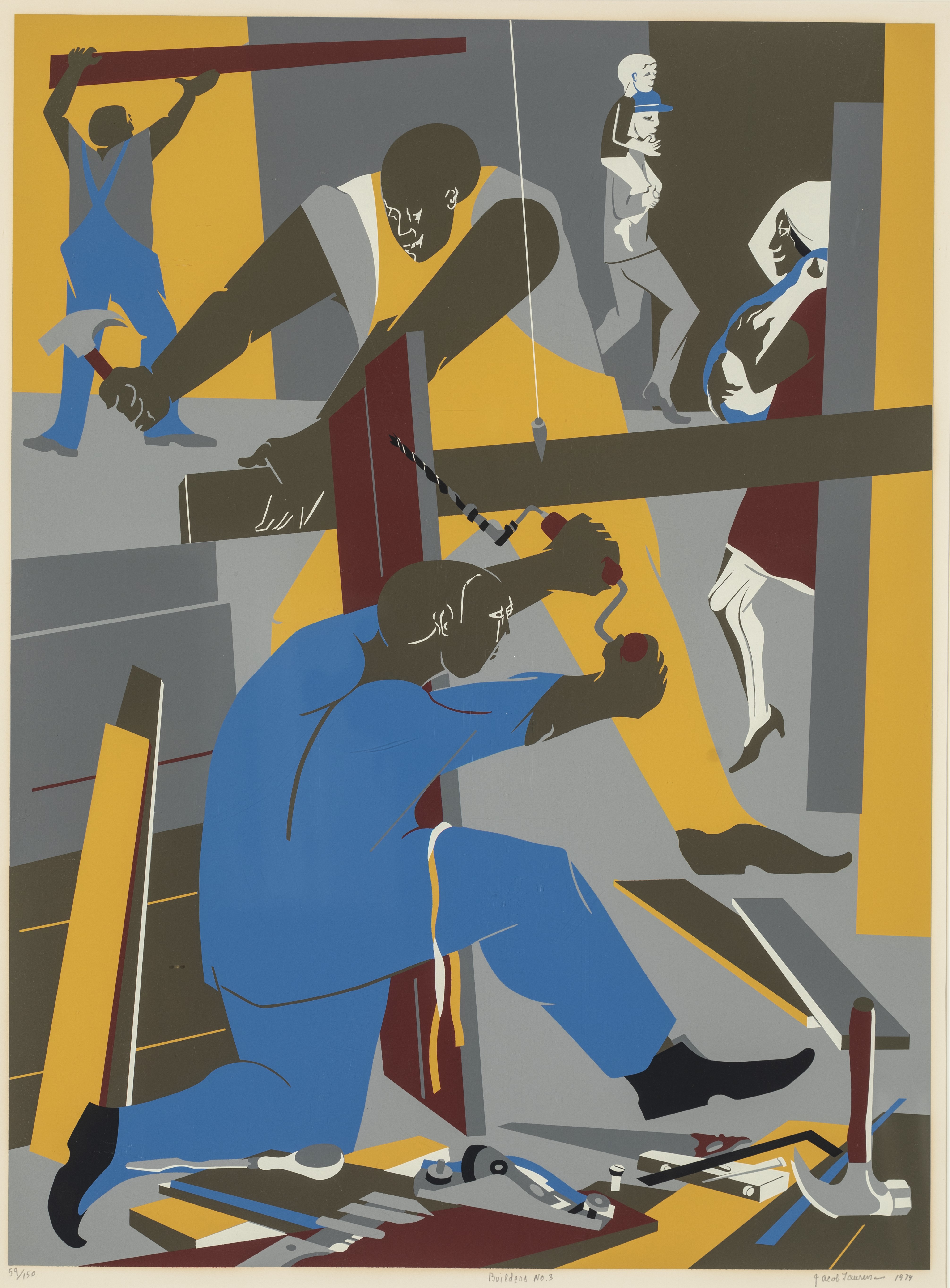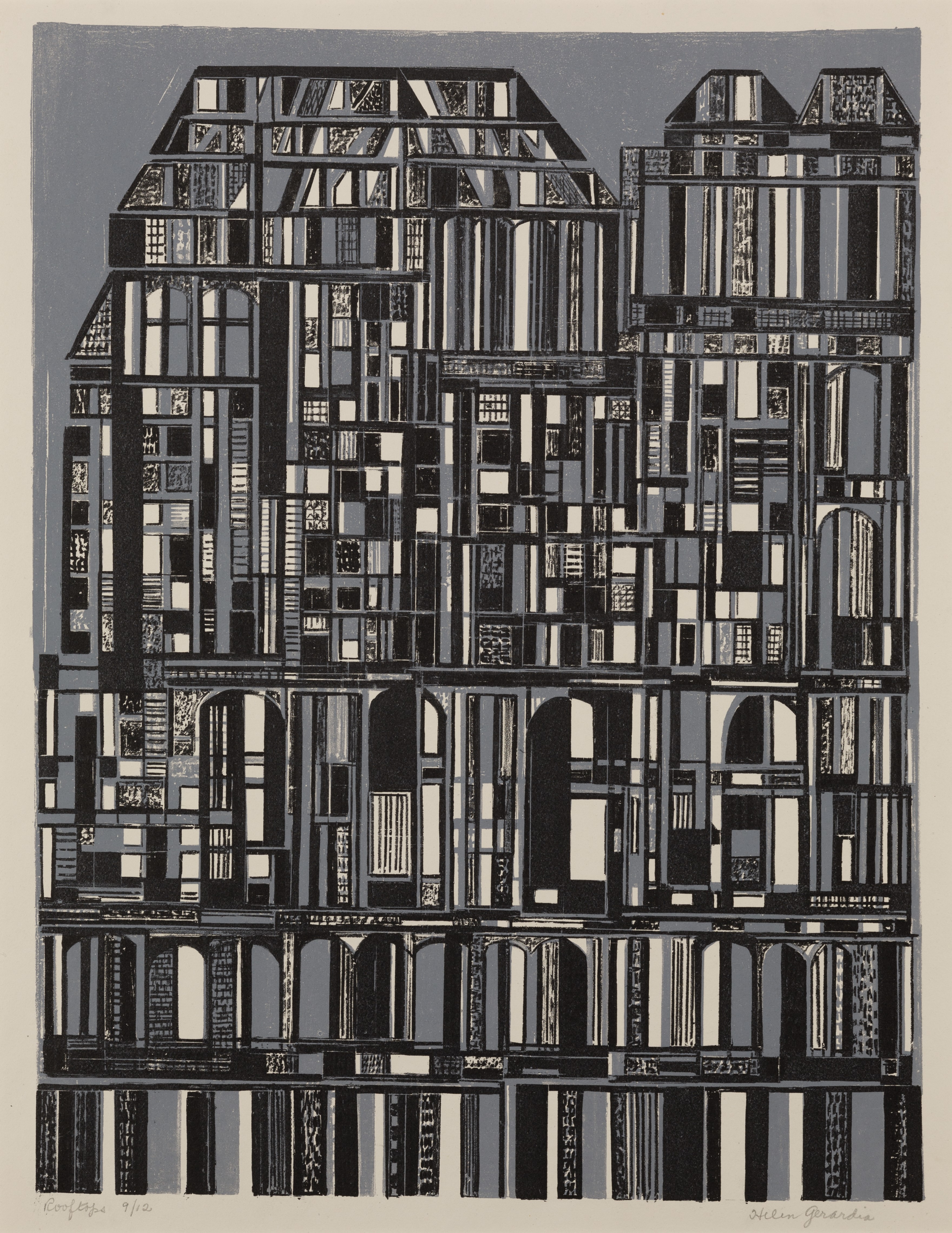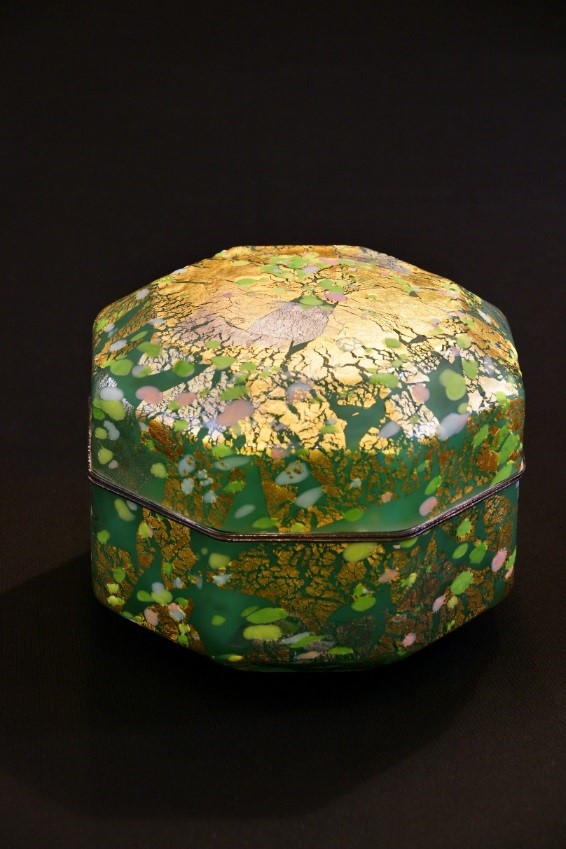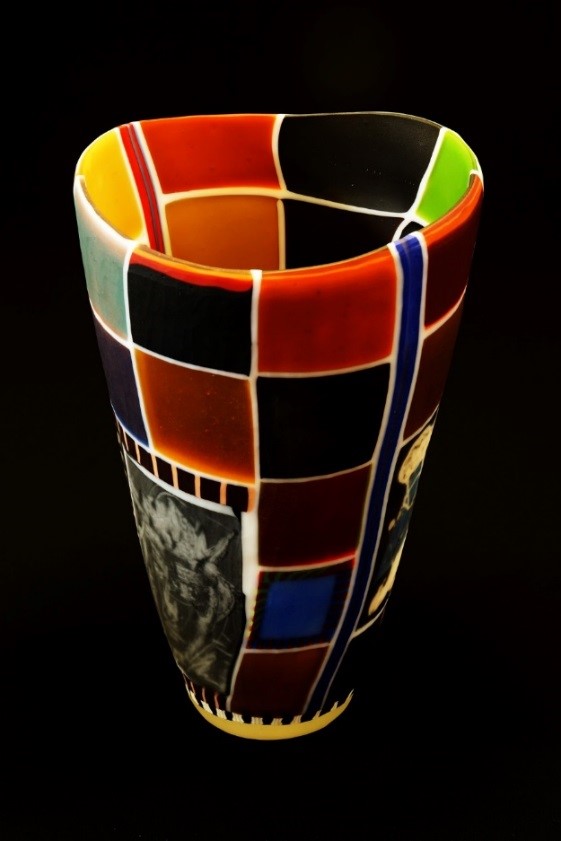

This powerful serigraph print from the permanent collection was created by Jacob Lawrence (1917-2000), one of this century's most widely acclaimed artists.
Lawrence was born in Atlantic City, New Jersey, but moved to Harlem, New York, at 13. He is among the few painters of his generation who grew up in a Black community, received instruction primarily from Black artists, and was influenced by the experiences of Black individuals.
Lawrence's artwork portrays the lives and struggles of the Black community, capturing their experiences through several series focused on figures such as Toussaint L'Ouverture, Frederick Douglass, and Harriet Tubman, as well as themes related to life in Harlem and the civil rights movement of the 1960s. His style is characterized by vibrant colors and abstract forms.
In the 1940s, during a time of widespread segregation, Lawrence broke racial barriers by becoming the first Black artist whose work was acquired by the Museum of Modern Art in New York City.
He stated, "If at times my productions do not express the conventionally beautiful, there is always an effort to express the universal beauty of man's continuous struggle to lift his social position and to add dimension to his spiritual being."
Researched and written by:
Julianna Collins, Stamelos Gallery Center former intern, UM-Dearborn art history/museum studies graduate, Class of 2025

This dynamic lithograph print from the permanent collection was created by Helen Gerardia (1903 - 1988), a painter and printmaker who worked primarily in New York.
Born in what is now Dnipro, Ukraine, Gerardia immigrated to the United States and settled in New York. She worked as a public school teacher in New York City before beginning her art studies at the Art Students League of New York in 1947, aiming for a professional career as an artist. Gerardia continued her education at the Hofmann School under the Abstract Expressionist Hans Hofmann (1880–1966).
Her first solo exhibition took place in 1953. She became an original member of the Vectors, a group of New York artists with strong female representation, formed in 1957. While Hofmann's Abstract Expressionist style influenced her early work, Gerardia’s interests shifted to Cubism and hard-edged, precise geometric abstraction. Her work reflects her fascination with geometry, engineering, architecture, and the urban landscape.
The artist stated, "I have always been interested in the play of light and its effect on form and color. Another quality of light, the prismatic breaking up of color, has always fascinated me. I felt that by placing my color in broken areas, I could, in a way, approximate the movement of atmosphere and the divisibility of color."
Researched and written by:
Julianna Collins, Stamelos Gallery Center former intern, UM-Dearborn art history/museum studies graduate, Class of 2025

This intricate print etching is a highlight of the permanent collection.
Giovanni Battista Piranesi is renowned for his extensive series of etchings portraying Roman monuments ranging from ancient to 18th century. Trained in architecture and engineering in Venice, he was also a trailblazer in archaeology. His prints were widely circulated, and he became one of the most influential architects, designers, and printmakers of his era.
Spending his early years in Rome studying and sketching ancient architecture, Piranesi quickly mastered etching techniques. He featured in his images fantastic complexes of buildings that could exist only in imagination and he depicted in meticulous detail the aqueduct system of the ancient Romans. The pieces that resulted from his extensive research were compiled into four volumes titled Antichità Romane, published in 1756. This series earned him election to the Society of Antiquaries of London, an academic society of historians and archaeologists in the United Kingdom.
As depicted in Ruins of the Mausoleums Along the Via Appia, Piranesi balances the scenic appearance of Roman architecture with his detailed descriptive text on one plate.
The artist stated, "I need to produce great ideas, and I believe that if I were commissioned to design a new universe, I would be mad enough to undertake it."
Researched and written by:
Julianna Collins, Stamelos Gallery Center former intern, UM-Dearborn art history/museum studies graduate, Class of 2025

This stunning, untitled, cast glass piece from the University of Michigan-Dearborn’s permanent art collection was created by František Vizner (1936 - 2011). Vizner, a world renowned, major Czech glass artist, was trained at the famous glassmaking schools in Nový Bor and Železný Brod before completing his studies at the Academy of Applied Arts in Prague. This work is a beautiful illustration of the artist’s passion for creating harmonious, geometric objects instilled with internal tension. His luminous art demonstrates elegance, simplicity, remarkable craftwork, and a deep admiration for the material. Vizner created his works on his own, without assistants, through a lengthy process of casting, sandblasting, acid-etching, and hand-polishing.
Vizner’s work is represented in public and private collections around the world including the Museum of Decorative Arts in Prague, the Metropolitan Museum of Art in New York, the Corning Museum of Glass in Corning, N.Y., the Victoria and Albert Museum in London, and the Musée des Arts Décoratifs in Paris. This piece was generously donated to UM-Dearborn by Robert Loeffler.
---Laura Cotton, Art Curator and Gallery Manager

American glass artist Dale Chihuly (b. 1941) found inspiration for his Basket series in 1977 from Northwest Coast Indian baskets in the collection of the Washington State Historical Society. Chihuly stated “I was struck by the grace of their slumped, sagging forms. I wanted to capture this grace in glass.” This piece is composed of muted colors and simple design patterns. Chihuly collaborated with James Carpenter and students of Pilchuck Glass School to develop this “pick-up drawing” technique in which glass threads are laid out to resemble designs influenced by Native American textiles. The composition of threads is then fused onto a glass vessel in its molten stage creating the glass-thread drawing effect. Chihuly regards his early Basket series as his “breakthrough” in understanding the manipulating properties of heat and gravity to produce these organic and asymmetrical forms.

This remarkable work reflects highly regarded American glass artist William Morris’ (b. 1957) earliest glass blowing period. Morris worked as chief gaffer under mentor and friend Dale Chihuly and shared his interest in ancient civilizations, mainly finding inspiration from Native American culture. Morris has described his work as having symbolic meanings attributed to the past, and he has created an artistic style out of incorporating primitive origins into modern glass sculptures. This piece reflects a Native American color scheme with a muted brown vessel and earthly tones of blue and beige found in the picked-up abstract sections. The fine thread of black glass trails through the piece providing a spiritual beginning and end from the top to the bottom of the vessel. The artist focuses on blending the alluring qualities of nature and his appreciation of the past with modern sculptural glass blowing techniques.

Michigan native Richard Ritter (b. 1940) was first exposed to hot glass in 1968 and quickly became convinced that glassblowing was the media that he had been searching for to begin his life's work. For this compelling piece, Ritter used an Italian glassblowing technique called murrini. Murrini is an Italian term for colored patterns or images made with bundles of glass cane (long rods of glass) that are revealed when cut in cross-sections. Ritter combines crystal and murrini canes to construct complex three-dimensional glass matrixes. His intricate platter pieces are initiated on a blowpipe and use the pick-up technique of adding premade patterns of murrini to the outside of the glass. Crystal is then gathered to round out the piece and form a foot for the platter to stand on. So as not to distort his meticulous murrini mosaics, Ritter pulls the glass out, “almost like a pasta,” rather than spinning it- as is typically done when creating a platter of this style.

Janet Kelman (b. 1948) lives and works in Ann Arbor. She has a background in chemistry and fell in love forty years ago with the aesthetic qualities of glass and the many ways in which it can be manipulated. Kelman’s work became deeply influenced by the sea when she learned how to scuba dive. The artist has stated “My seafans begin as handspun circular plates. I cut a floral shape out of them with a sandblaster and carve one entire surface into undulating swirls. I work slowly because if the glass heats up too much, it will crack. It takes about twenty hours to lay out the design and do the sandblasting. Each piece is then slumped, around seven times, into a bowl-shaped mold and I hope that the glass will ruffle at the edge as it goes in. I then fire the bowl up-side down and let it deconstruct and then fire it again right-side up. I often close and open it again to achieve a lively result. Each firing takes two days.”

World renowned artist Kyohei Fujita was born in Japan in 1921. He is known as the father of Japanese studio glass. Many of his works, including this one, were inspired by early Japanese boxes that were richly decorated with lacquerwork and mother-of-pearl inlays, and traditionally used to store Buddhist writings, jewelry, inkstones and brushes. Fujita’s celebrated ornamental glass boxes revive conventional Japanese aesthetics in a contemporary form. This breathtaking piece was mold blown with gold and silver foil inclusions. Whenever asked by collectors what to keep in the boxes, the artist usually stated “You should put your dreams in them.”

Celebrated glass artist Colin Reid was born in England in 1953. He is regarded as a pioneer in the field of kiln cast glass and his major areas of exploration are texture, movement, energy and flow. Reid enjoys highlighting the contrasts between rough and polished surfaces and he prefers working with cast, solid glass because it allows him to play with the light coming from the interior of the form. Reid has stated, “My current interest is in natural materials that have been worked by craftsmens’ hands in the past and are now eroding and reverting back to nature, like medieval stone carvings. I use various moulding techniques to cast my glass, and my firings are usually about three weeks long so that I can achieve the correct thickness and depth. After the piece comes out of the kiln, there’s a long process of grinding, polishing and sandblasting. The work changes and evolves throughout the process and a lot is based on chance. The tension between what is planned and controlled and what is unexpected can be both creative and disastrous. I do not open the kiln if I’m having a bad day. The quality I’m after is elusive and impossible to describe….. but I know it when I see it.”

This is one of Harvey Littleton’s remarkable, rare, early works and possibly one of the most significant pieces in UM- Dearborn’s collection. It represents how the studio glass movement of the 1960s began. Littleton was born in Corning, NY in 1922. His father was a physicist and glass researcher for Corning Glass Works. Littleton, known as the father of American studio glass, started out as a ceramicist and wanted to experiment with glass. He took a progressive and innovative approach to glass and encouraged artists to push beyond tradition to create pieces that are more than functional and saleable. Littleton played an integral role in making studio glass an appropriate medium for artistic expression. He created this piece by manipulating the glass on the end of a punty and flipping it over to create a sculptural result. At the time that this piece was made, no one else was doing anything else like it.

Glass artist Lucio Bubacco was born in Murano, Italy in 1957. He is highly regarded as one of the top masters of flameworking in the world. The artist feels that his real strength lies in having a deep understanding of how the material behaves and a great knowledge for the science of glass fusing and color compatibility. He is known for his unique, imaginative, hand-formed human and fantasy figures and the theatrical, narrative aspects of his work. Bubacco is inspired by Greek, Roman and Byzantine classic art and medieval and renaissance theater. He uses Murano “soft glass” which is high in soda content and is famous for its brightness. Flameworking is a highly detailed and precise method of forming and manipulating glass rods into desired shapes by using tweezers and a table top torch.

For this piece, American glass artist Scott Gamble used the traditional method of hand blowing and hot sculpting. To achieve the mystical, smoky transparency of the surface, Gamble used a technique called sand etching. Etching creates texture on the surface of glass through the application of acidic, caustic, or abrasive substances- such as sand. Sand etching, also referred to as sandblasting, is essentially the process of blasting the glass with grit which strikes the surface, giving it a milky white appearance.
Gamble retained the original clear glass seen swirled within the frosted glass by covering paper over the portions he wanted to be exempt from the abrasive blasting. The artist’s final step was to acid polish the entire surface for an overall smooth and glossy appearance. This process consists of dipping the piece into a mixture of undiluted hydrofluoric and sulfuric acids. A heat releasing exothermic reaction occurs, dissolving the finest top layer of the glass and producing the final polished piece.

Australian glass-making duo Ben Edols and Kathy Elliott have been creating glass art together since 1993. For this pair of stunning works, the remarkable surface texture was created after the glass had been blown on a pipe and cooled. This cold-working finishing treatment is called battuto which means “struck or beaten” and is achieved by using a grinding wheel to mark the surface of the glass. The grindings are made to differing depths and with overlapping irregularity to create a faceted fish scale or hammered metal effect.

Highly regarded American artist David Huchthausen draws inspiration from primitive arts and rituals. Ritual Figurines developed from his interest in the Mesoamerican Olmec culture. While visiting an Olmec grave site on La Venta Island in Mexico, Huchthausen became fascinated by the massive 30-ton basalt heads and thousands of “miniature baby-faced heads” found buried in long pits on the sacred grounds. Anthropologists believe the ritualistic stone heads were placed around the tomb of an Emperor to provide protection in the afterlife.
The artist translated these ancient influences into his series Ritual Figurines. He created his own blown glass version of the mysterious figurines using earthen hues of olive green, stone gray, milky white and amber. To recreate the stone-like texture of the Olmec basalt heads Huchthausen added sand to the molds used for his cast bronze “baby” faces.

New Zealand artist Ann Robinson is a distinguished master in the lost-wax casting technique. Robinson’s tedious process consists of creating a plaster, two-piece refractory mold that is heat resistant to the high temperatures of a kiln. Melted wax is then poured into the refractory mold and left to cool and harden. Once hardened, the wax mold is removed and Robinson creates her designs on the surface of the wax with etching and cutting tools. Next, a second heat resistant mold is applied around the wax mold. This second mold takes on the design elements of the wax mold and will be used to create the final piece. The mold is then placed in the kiln and the interior wax is removed or “lost” through hot steam. Finally, after all the wax is drained, a cavity is formed. Glass pieces called billets are filled into the cavity and returned to the kiln. The piece is then heated and slowly cooled to prevent cracking. The second mold is broken off and the cast piece is grinded and polished to produce a fully sculptural piece as seen in Te Rito Pod (Kelp).

Italian artist Dino Rosin grew up on the glassmaking island of Murano, Italy. Rosin began his career as an apprentice at age twelve, later joining his glassmaking brothers, Loredano and Mirko, in their factory. During the twenty year span of the brothers’ collaborations Rosin became a master at cold-working. Cold-working is performed by an artist either before or after hot-work using a kiln, furnace, flame, or torch.
Cold-working is used to smooth off, polish and shape edges or flat or curved surfaces, create texture, or expose underlying glass. The polished, smooth appearance of Maternity is a great example. To achieve the brilliant rainbow of coloration in this work, Rosin used the ancient technique of calcedonia. The rich colors are created by mixing copper, iron, cobalt and tin oxides with metallic silver into the glass and manipulating temperature and duration in the furnace to achieve the desired effect. The calcedonia method has made Rosin’s pieces highly recognizable and unique within the studio glass world.

Australian glass artist Scott Chaseling (b. 1962) attended the Australian National University’s Canberra School of Art in 1995. In a collaborative project with fellow glass artist Klaus Moje, the two artists invented the Australian Roll-Up technique. Their process is quite similar to the traditional Venetian murrini cane pick-up method with one major difference. Chaseling and Moje’s concept involves picking up pre-fused panels of glass. This innovative approach allows artists to create carefully controlled designs that are not possible with traditional glassblowing methods. The pre-fused sheets of glass allow varying interior and exterior imagery, precise color placement, and full cross-sections of color, all seen in the skillful craftsmanship of this piece. After picking up the pre-fused panels on a punty, a glass blowing pipe, the final steps to the Australian Roll-Up technique consist of blowing, rolling and manipulating the glass form into a finished standing vessel shape.

Glass and jewelry artist Helen Aitken-Kuhnen (b.1952) finds color and mass to be the most crucial elements when creating new artistic works. Through the medium of glass she is best able to experiment in these areas and has discovered a new range in her creativity and artistry. In her Drought Bowl series Aitken-Kuhnen demonstrates her considerable mastery in casting glass pieces. Her technique consists of using various tiles of glass to create dense patterns in a solid form. In the simple geometric form, Blue Iris Bowl (Mauve), Aitken-Kuhnen embedded vivid iridescent mosaic-like structures into the solid purple casting. The bowl was then polished to reveal luminescent and transparent qualities that capture, reflect and transport light, giving the work an inner glow. The base of the piece is meticulously cast with the artist’s signature zigzag motif, inside and out.

Renowned glass artist Nick Mount (b.1952) is a leading figure within the Australian studio glass movement. He has been a dominant part of the glass field since the early 1970's and draws inspiration from traditional Venetian glass methods. In Mount’s work he aims to capture the fragility and fluidity of ancient glass in his blowing and coloring approach while adding his own assortment of blown, cut and polished elements to form uniquely random and alluring fabrications.
Mount has stated, “I enjoy working within the restrictions imposed through the pursuit of excellence in traditional furnace working of glass but also take pleasure from the excitement of selecting unrelated blown forms and joining them to create improbable compositions.” With this piece, Mount illustrated his compelling mesh of past and present techniques. The conventional blown vessel form used commonly in apothecaries and perfumeries brings a traditional aspect while Mount’s peculiar, contrasting adornments create a modern element- making the piece a highly-regarded, new age, studio glass work.

Jacob Lawrence (1917-2000), Serigraph print, 1974
Gift of Gilbert M. Frimet,
Collection of UM-Dearborn (1980.065)
Photographed by Tim Thayer
This powerful serigraph print from the permanent collection was created by Jacob Lawrence (1917-2000), one of this century's most widely acclaimed artists.
Lawrence was born in Atlantic City, New Jersey, but moved to Harlem, New York, at 13. He is among the few painters of his generation who grew up in a Black community, received instruction primarily from Black artists, and was influenced by the experiences of Black individuals.
Lawrence's artwork portrays the lives and struggles of the Black community, capturing their experiences through several series focused on figures such as Toussaint L'Ouverture, Frederick Douglass, and Harriet Tubman, as well as themes related to life in Harlem and the civil rights movement of the 1960s. His style is characterized by vibrant colors and abstract forms.
In the 1940s, during a time of widespread segregation, Lawrence broke racial barriers by becoming the first Black artist whose work was acquired by the Museum of Modern Art in New York City.
He stated, "If at times my productions do not express the conventionally beautiful, there is always an effort to express the universal beauty of man's continuous struggle to lift his social position and to add dimension to his spiritual being."
Researched and written by:
Julianna Collins, Stamelos Gallery Center former intern, UM-Dearborn art history/museum studies graduate, Class of 2025